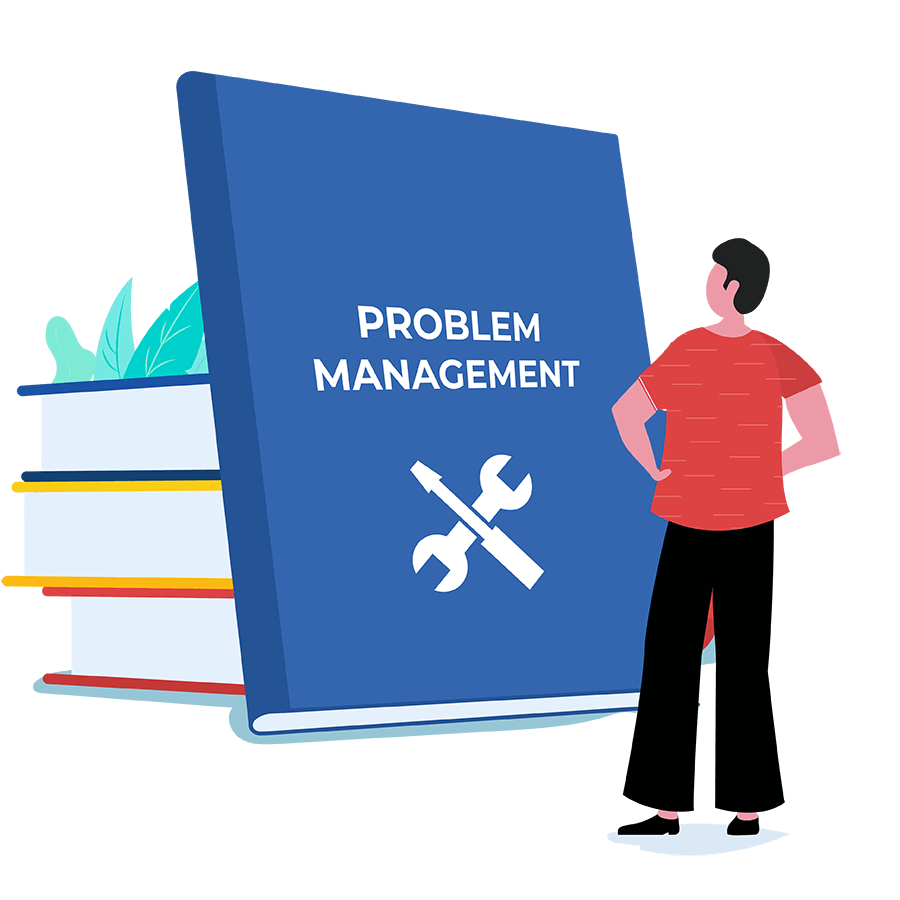This is the final section of our comprehensive guide on problem management. This section shines light on the various KPIs to measure in relation to your problem management efforts and how the right tool can provide you a head start on your problem management journey.
IT Problem management key performance indicators
Key performance indicators (KPIs) should provide value to users, technicians, and stakeholders alike. While these metrics act as a self-examination tool, it is advisable to limit the metrics to seven or eight for the problem management process since too many might provide a skewed perception of the process itself. There could be problems on the ground level, but the various metrics acting together could come to a different conclusion.
KPIs can vary according to the way an organization functions, so there isn't one single list of applicable metrics for all organizations. In order to determine which KPIs should be monitored, stakeholders should be asked to weigh in and decide what would be beneficial.
Below are the most applicable KPIs for the problem management process.
| KPI | Formula | Comment |
|---|---|---|
| Average time to start RCA | The average time taken from identifying a problem to initiating RCA. | This showcases the efficiency of the problem diagnosis team. |
| Average time to start RCA | The average time taken from identifying a problem to initiating RCA. | |
| Total number of uncompleted problems | The count of problems that are yet to undergo RCA. | This is different from an unresolved problem. Incomplete problems are logged, but work hasn't been started on them yet. |
| Percentage increase/decrease of major incidents | Percentage increase/decrease of major incidents | This metric can assist in finding trends, such as the frequency of problem occurrences. |
| Total number of problem records reported | The total number of problems logged from incidents. | As your problem management practice matures, the problems reported from incidents should go down. |
| Average resolution time of problems | The average time taken from identification to the resolution of a problem. | Problems can take a long time to be solved. To speed the process up, it helps to measure the improvement efforts in RCA and the actual problem management process. |
| Total number of known errors | The count of known errors in the KEDB. | This highlights your organization's documentation efforts. If the ratio between the number of problems logged and known errors is low, it's a good sign. |
| Total number of unresolved problems | The count of unresolved problems in the service desk. | Unresolved problems are ones with ongoing RCA. |
| Total/average number of incidents associated with problems | The count of all incidents with an associated problem ticket. | When trying to scale up your proactive diagnosing activities, ensure that this metric gradually recedes to a minimum. |
| Percentage of problems with an identified root cause | The number of problems that have a clear, identified root cause, compared to the overall logged problems. | Both of these metrics supplement other metrics, like the effectiveness of the problem management practice, and help with decision-making, such as monetary decisions. |
| Percentage of problems with a workaround | The number of problems that have a workaround in place rather than a permanent fix, relative to the overall logged problems. |
The best features for problem management software
It's easier for organizations to leverage software to formulate their problem management process rather than try to develop it from scratch. There are numerous solutions on the market that claim to be the best for problem management; at the very least, problem management software should feature the capabilities listed below.
| Feature list | Value | |
|---|---|---|
| Problem creation and logging | Create problems from an incident | Identify incidents of an underlying problem that require a full investigation, and associate changes. |
| Mark a problem as a known error | Maintain a KEDB. | |
| Create problem templates | Standardize the format for defining problems. | |
| Problem analysis | Problem roles and technician | Identify the problem owner. |
| Include analysis, impact, and RCAs for every problem | Analyze the impact, symptoms, and root cause of the problem, and document them. | |
| Mark services affected and assets involved | Precisely define each problem, and quantify the business impact. | |
| Problem solution | Add tasks with dependencies within a problem | Assign solution implementation to specific technicians with due dates. |
| Mark workarounds as solutions | Provide a temporary solution with a workaround, or a permanent solution to the problem. | |
| Associate a change with the problem | Make problem management work in tandem with other ITSM processes. | |
| Problem closure | Copy a problem solution and workaround to all associated incidents | Avoid redundant activities, and ensure consistent records on all tickets. |
| Close all associated incidents automatically on closure of the problem | Save technicians time and effort. | |
| Create work logs to record the cost, effort, and time taken to resolve a problem | Get detailed KPIs with respect to cost and time taken to resolve problems. | |
| Notification rules and announcements | Put notification mechanisms in place to keep stakeholders informed. | |
Conclusion

Problem management and its practices are flexible for all organizations irrespective of size, geographical spread, industry, and technology used to function every day.
Organizations with robust incident management should aim for a basic problem management setup by implementing a separate channel for logging and managing problems and maintaining a KEDB. As the problem management team's experience grows along with the organization, the process should mature as well.
For an organization that already practices problem management, its aspirations should lie in reducing incidents to an all-time low. This is most attainable through a proactive approach to problem management.
An easy first step in implementing the problem management process is to utilize a service desk tool with the right modules to ensure comprehensive IT service desk operations and centralized control of tickets, incidents, and problems. Having a streamlined problem management process in your organization is a long-term project that will pay off as your business grows and your IT infrastructure scales.
This is the sixth and final part to The Comprehensive Guide to Problem Management. The guide explores the multiple facets of IT problem management to help you properly prepare for your problem management journey in your organization.
You can check out the previous sections of the guide below, in case you missed any:
Assess your incident response readiness to kick-start your problem management journey
The zeroth step in the journey towards proactive problem management is establishing a robust incident management process in your IT environment. Discover how Zoho, our parent company, handles the spectrum of incidents thrown at it year over year and assess your incident management readiness at an enterprise scale.
Download a free copy of our incident management handbook and a best practice checklist to review your problem management solution.
-

Problem management feature checklist
-

IT incident management handbook

